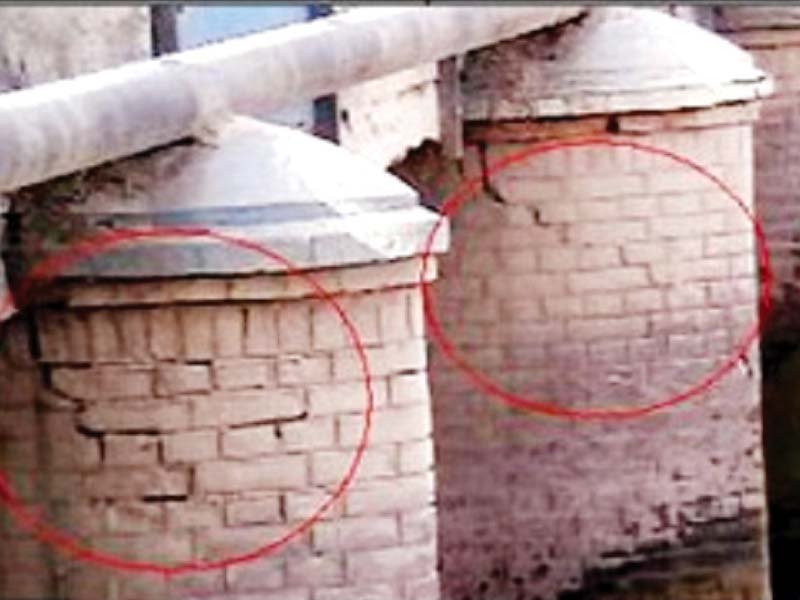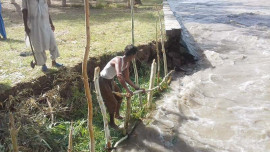
SUKKUR: After water discharge to Rohri canal declined to a dangerous 1,500 cusecs, the irrigation authorities have finally started repair work of the Phull Fall regulator near Naushero Feroz.
The trouble began following the collapse of some portion of the right and left flank walls of Phull Fall Regulator, situated on Naushero-Phull Link Road. When water started flowing out of the canal, the villagers rushed to plug the breaches themselves. They alerted the irrigation authorities but failed to get any response. By June 7, water discharge to Rohri canal was reduced from 14,000 cusecs to 4,000 cusecs to avoid further damage.
Rohri canal is one of the seven off-taking canals of Sukkur Barrage, which originates from barrage's left pocket and passes through Khairpur, Naushero Feroz, Shaheed Benazirabad and Hyderabad, and ends in Sanghar. The regulator itself has also developed cracks and strong current of water can prove to be the last straw on the camel's back, claimed an irrigation official, who requested anonymity.
According to him, 29 of Sindh's agriculture crops depend on the water from Rohri canal. Most people also get drinking water from this canal, he said, adding that prolonged closure will affect them.
Work begins
All arrangements have been made to start the repair work, said superintendent engineer of Khairpur circle, Imtiaz Memon, who has been deputed to oversee the repair work of Phull regulator.
First of all, a coffer dam is being constructed in the upstream of the regulator to stop water from flowing downstream, said an irrigation official, who requested anonymity. Sheet piles from Sukkur Barrage have been shifted to the Phull regulator to construct the coffer dam. He added that this process alone may take one week, after which the repair work will start, which will take another three weeks to complete. The officer believed that no inspection was done during the annual closure of canals in January otherwise this wouldn't have happened.
However, Memon denied his claim. Every year, the inspection of all structures is carried out thoroughly during the annual closure and it is not possible to overlook such things, he said. He estimated that Rohri canal will be closed for 15 days during which the repairs will be carried out.
Fault in our system
Meanwhile, former irrigation secretary Idrees Rajput told The Express Tribune that it is not possible for the irrigation officials to ignore such a big fault in any structure. If the problem was persisting for the last couple of months, then how is it possible that the flank walls remained intact till now, he asked.
Last month, irrigation employees were on a tool-down strike and, during that period, they stopped monitoring different regulators to maintain proper gauges, he pointed out. It seems that, during that period, mismanagement — such as abrupt raising or lowering of regulator gates — might have caused damage to the flank walls, he added. Rajput was of the view that it may take up to one month to put the regulator back into operation.
Talking about losses to the agriculture sector, Rajput said the closure of Rohri canal will cause extensive damage to the Kharif crops, such as cotton, sugarcane, paddy and others in Khairpur, Naushero Feroz, Shaheed Benazirabad, Hyderabad, Sanghar and Badin districts.
Following the incident, Sukkur Barrage chief engineer Wali Mohammad Naich was neither available at his office nor was he in touch with the subordinate staff. He was unavailable for comments via telephone as well. Phull Fall regulator's executive engineer Abid Naich is also unavailable for comments.
Published in The Express Tribune, June 10th, 2016.




























































COMMENTS
Comments are moderated and generally will be posted if they are on-topic and not abusive.
For more information, please see our Comments FAQ